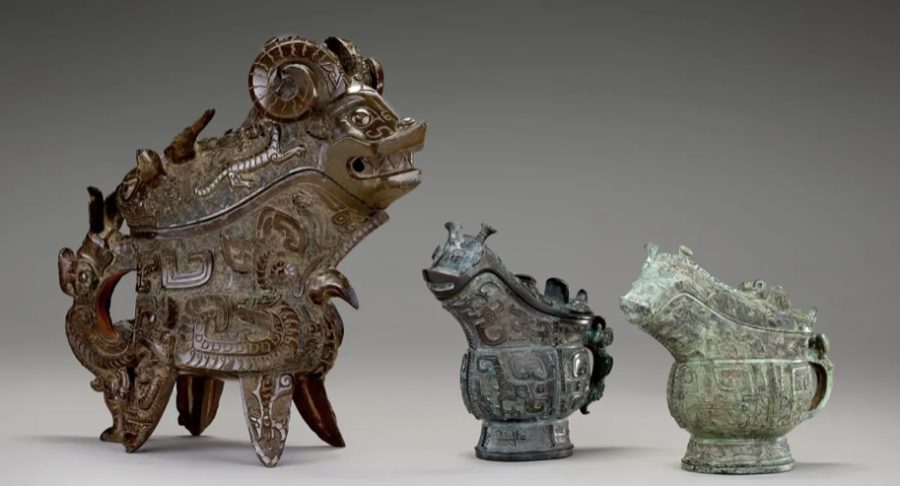Ancient bronze exhibit deserves a gold star
Photo courtesy of the Smithsonian Institute
The three bronze ritual wine pouring vessels will be featured at the new exhibition at the National Museum of Asian Art. The exhibition, “Anyang: China’s Ancient City of Kings,” is debuting on February 25, 2023 and will display works from Anyang, the captal city of the influential Shang dynasty.
March 30, 2023
3500 years ago the Bronze age was at its peak: metals were, for the first time, transformed from merely a lump into intricately detailed forms of art. During this period, the Shang Dynasty was born. At the heart of the empire was Anyang, the capital city, where kings ruled over this influential dynasty. Its cultural impact was forgotten after thousands of years of progress, yet the National Museum of Asian Art (NMAA), located in Washington D.C., chooses to maintain its memory with its new exhibit. On February 25, 2023, the NMAA, in celebration of its centennial, introduced the first large exhibit in the United States about the capital city– “Anyang: China’s Ancient City of Kings.”
“I think this exhibit is a great way to celebrate the museum’s centennial,” WCHS junior Kanza Ihsan said. “As the National Museum of Asian Art highlights a lot of modern, present-day installations from Asia, I think it’s really valuable for its visitors to understand the heart and birthplace of this art, which would be achieved through the Anyang exhibition.”
The NMAA took its place at the National Mall in 1923, meaning this year marks 100 years since the museum’s opening. Over the past 100 years, it has formed a reputation as a source of history and research. This exhibition, in particular, is a collection of artifacts that give insight regarding the cultural origins of other more modern NMAA pieces.
“What this exhibit does is that it allows you to see just how artistically skilled society was,” WCHS AP World History teacher Christopher Forney said. “It allows you to be able to infer elements about the human experience around three thousand years ago.”
The exhibit gives its viewers a greater understanding of the workings of ancient human civilizations. Over time, society has vastly evolved by taking its origins and building upon them. By attending the Anyang exhibit, one can see how different the lives of ancient people were and their practices.
“The artifacts themselves are very interesting from a sole artistic point of view; the raw traditional materials used to make them, the spiritual practices behind them and the meaning underlying every detail,” WCHS junior Mira Wedam said. “I’d love to look into these traits by attending the exhibition.”
The artifacts that take part in the exhibition are all unique and significant to understanding the Shang culture. The NMAA has stated that over 200 pieces will be at the exhibition: ceremonial weapons, jade ornaments, oracle bone inscriptions, ritual bronze vessels, and more.
“The oracle bone inscription pieces seem the most fascinating to me,” Wedam said. “The origin of languages and how each unique language has spread to connect populations of millions of people is always difficult for me to wrap my head around. To have firsthand evidence of what is likely the origins of the Chinese language, which is now spoken and used in the most populous country in the world, is amazing.”
According to Encyclopedia Britannica, the Shang dynasty was the first Chinese dynasty to leave both written and archaeological records. By having these records, historians can understand the characteristics of these people and what kinds of accomplishments they had. One specific accomplishment of the Shang dynasty was its formation of the Chinese language.
“Language is incredibly important for the advancement of a nation in terms of communication, scientific advancement, maintaining social order, and countless more aspects of a society,” Wedam said. “Anyang’s role in the development of language is what allowed for China to develop into the influential nation it is today.”
The Shang dynasty was a key contributor in building China’s cultural foundation. By being exposed to intricately designed artifacts from this time period, visitors can dive into the everyday lives of ancient civilizations.
“I think [the exhibition] has to be interesting as a glimpse into the past,” Forney said. “China is culturally really rich. The Shang Dynasty specifically pioneered architectural style [and created] a written language that is going to be influential across Asia.”
The impact of Anyang, and the Shang dynasty, is often overlooked. Even those who are art and history savvy, are less aware of ancient Asian history. “Anyang: China’s Ancient City of Kings” will give WCHS students, and other visitors, a better understanding of a culture that they are likely unaware of.
“The exhibition is important for students to enhance their understanding of the origins of East Asian culture and art, a subject much too often overlooked by the modern education system,” Ihsan said. “As an art history student, I would love to learn more about art from ancient Asian culture, but unfortunately, the course has a major lack of that. That’s why I feel that an exhibit that represents such a rich yet often unseen history and culture is very worthwhile to attend.”



